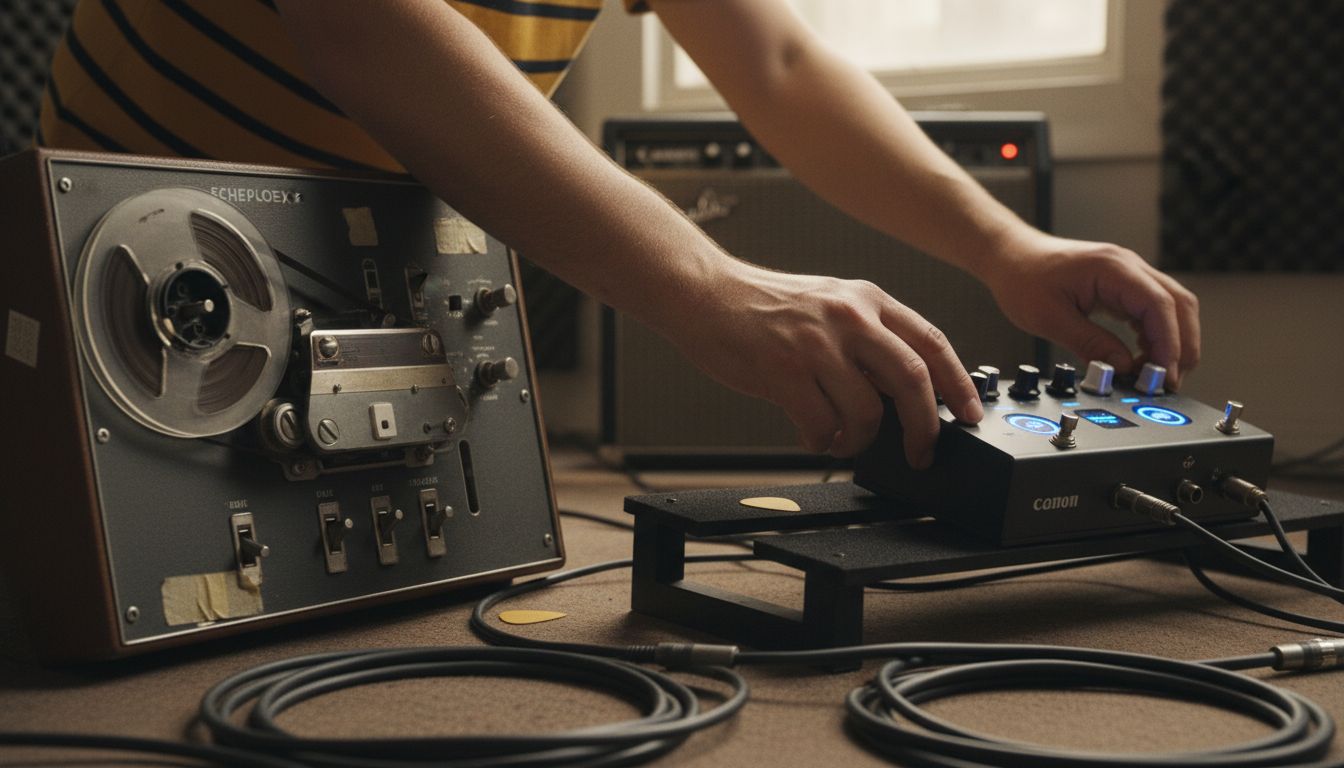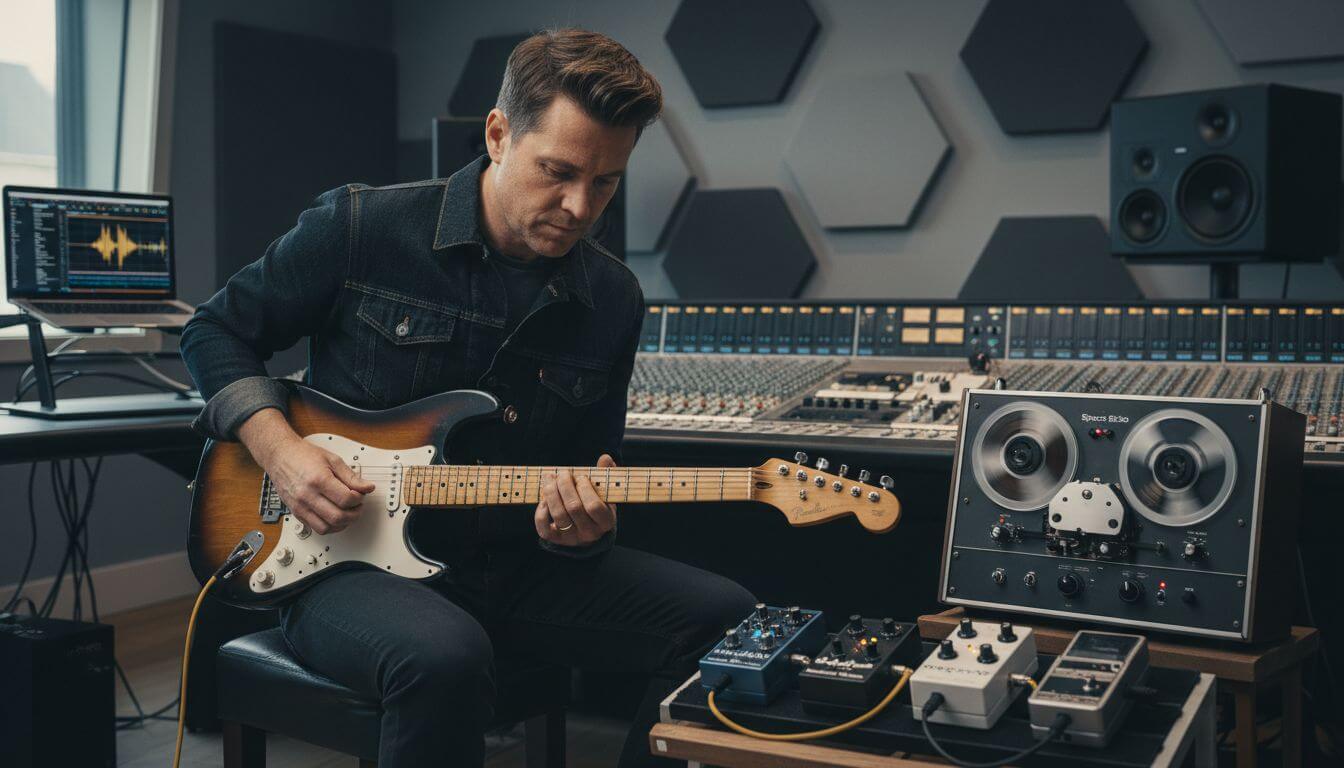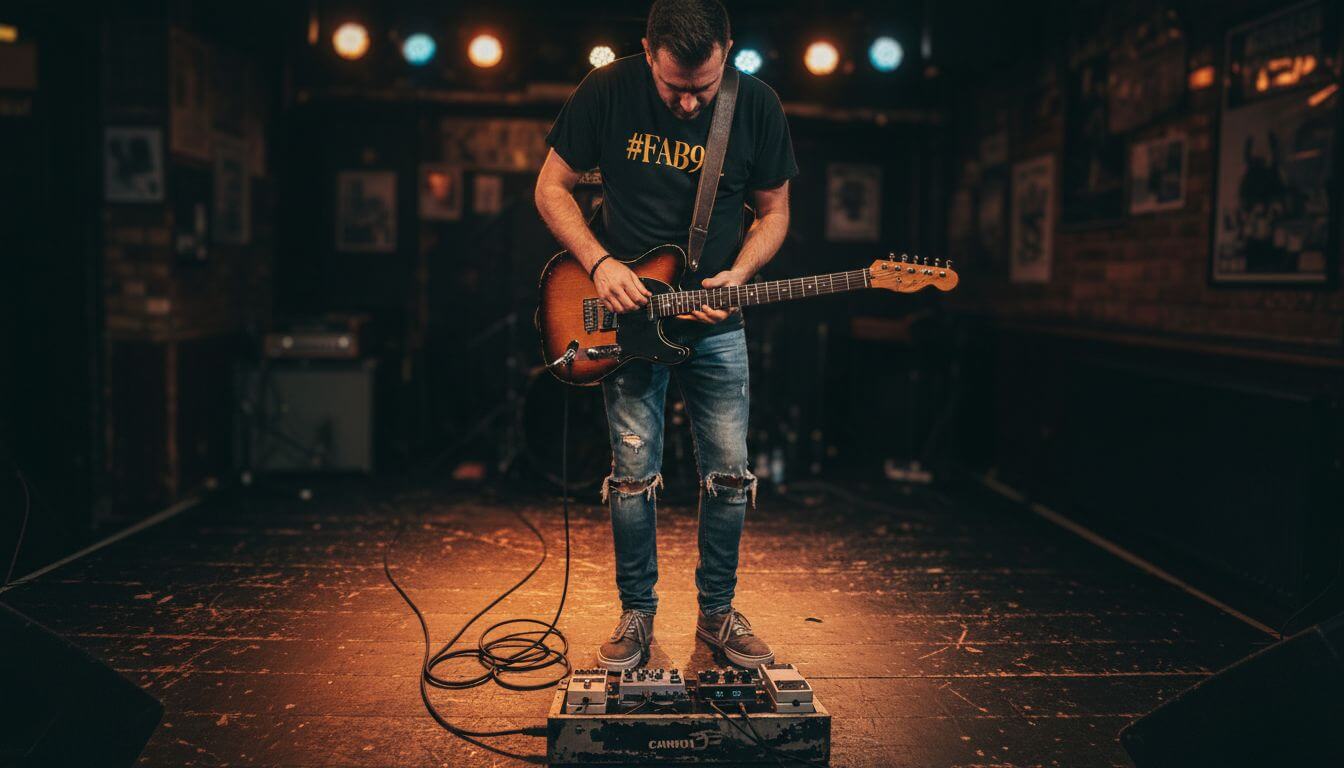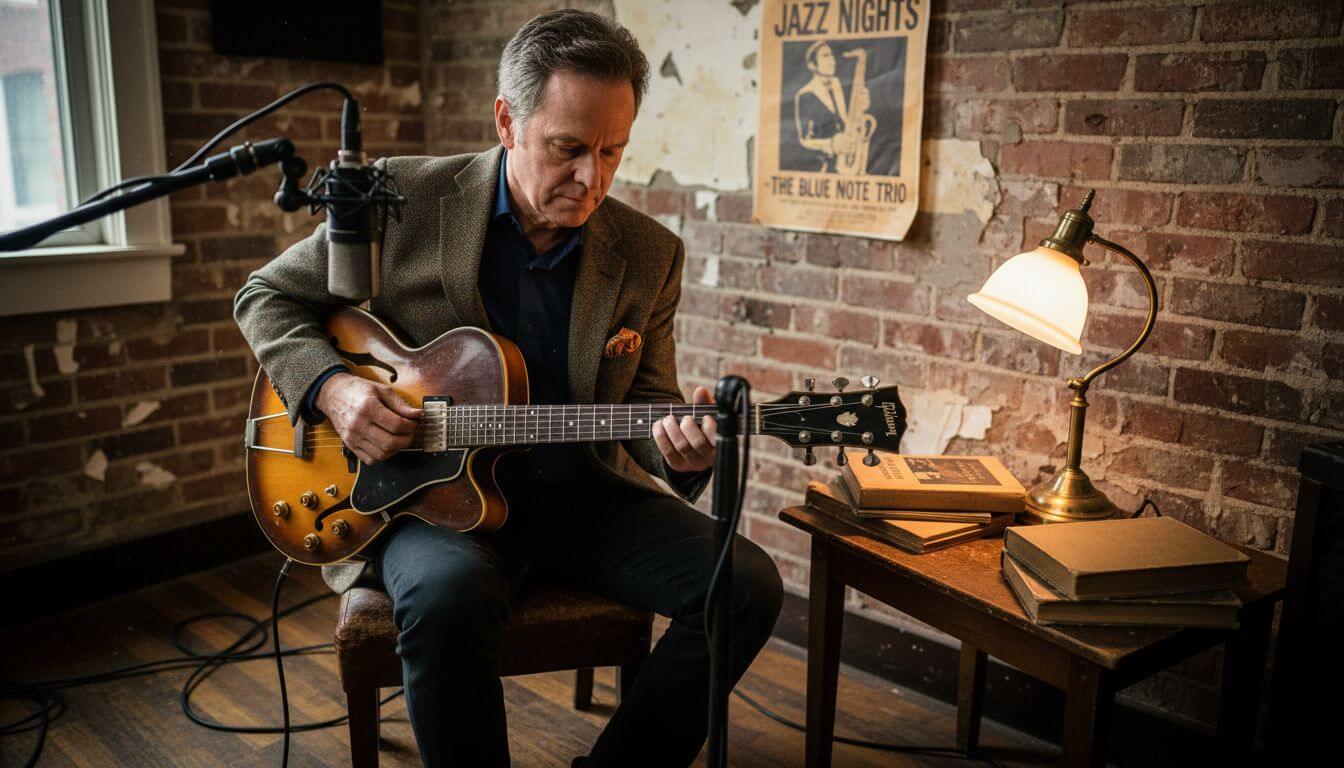Did you know that a true echo separates from the original sound by at least 50 milliseconds according to acoustic research? Echo shapes the way music feels, transforming simple notes into rich and textured soundscapes. Understanding how echoes work with guitars and audio equipment helps musicians create unique atmospheres and powerful moments. Whether aiming for vintage warmth or crisp digital effects, the right echo technique can turn an ordinary performance into something unforgettable.
Table of Contents
- Defining Echo In Music And Audio
- Types Of Echo: Analog And Digital
- How Echo Effects Work On Guitar
- Popular Echo Uses In Guitar Gear
- Common Mistakes And Setup Tips
Key Takeaways
| Point | Details |
|---|---|
| Echo Fundamentals | Echo occurs when sound waves reflect off surfaces, creating distinct repetitions that enhance musical expression. Understanding the delay time is crucial for achieving desired effects. |
| Types of Echo | Echo effects can be categorized into analog and digital, with each type offering unique characteristics in sound quality and control options. Analog provides warmth, while digital allows precision. |
| Common Techniques | The slapback echo, common in guitar and vocal performances, adds depth and dimension through quick sound reflections, typically between 40-120 milliseconds. |
| Setup Strategies | Effective echo setup involves careful management of delay time relative to tempo, minimal feedback adjustments, and strategic signal chain placement to avoid sound muddiness. |
Defining Echo in Music and Audio
An echo is a fascinating acoustic phenomenon where sound waves bounce off surfaces and return to the listener as a distinct repetition of the original sound. According to research from Simon Fraser University, for a sound reflection to be considered a true echo, it must occur at least 50 milliseconds after the original sound and remain audibly separate from other surrounding sounds.
In musical and audio contexts, echo occurs when sound waves interact with solid surfaces like walls, ceilings, or large objects, causing them to reflect and create a delayed replica of the original sound. As research from acoustic studies indicates, environments with flat, smooth, and perpendicular surfaces are particularly effective at generating pronounced echo effects. Delay Pedal Types can help musicians intentionally recreate and manipulate this natural acoustic phenomenon.
For guitarists, understanding echo is crucial because it dramatically influences sound quality and musical expression. The time delay between the original sound and its reflection determines the character of the echo - shorter delays create a subtle, almost imperceptible effect, while longer delays produce more distinct, separate sound repetitions. Musicians often deliberately use echo to add depth, dimension, and atmospheric qualities to their performances, transforming a simple sound into a rich, textured auditory experience.
Types of Echo: Analog and Digital
Echo technologies have evolved dramatically since the 1950s, with two primary types emerging: analog and digital echo effects. According to research from Wikipedia, electric echo effects first gained prominence with the Echoplex tape delay device introduced in 1959, which mechanically recreated sound reflections using magnetic tape technology.
Analog echo systems rely on physical mechanisms to produce sound repetitions. These traditional methods often use tape machines or bucket brigade devices (BBD) that physically move sound signals through a series of electronic components, creating a warm, slightly degraded echo effect prized by many musicians. By contrast, digital echo technologies use electronic circuitry to sample, store, and reproduce sound with precise mathematical calculations, offering musicians cleaner and more controllable echo variations.
Here’s a comparison of key differences between analogue and digital echo effects:

| Feature | Analogue Echo | Digital Echo |
|---|---|---|
| Technology | Tape machines Bucket Brigade Devices |
Electronic circuitry Digital sampling |
| Sound Quality | Warm Slightly degraded |
Clean Highly precise |
| Control Options | Limited Manual adjustment |
Extensive Programmable parameters |
| Popular Era | 1950s–1970s | 1980s–present |
| Typical Use | Vintage tones Distinct character |
Modern sounds Versatile control |
A popular echo technique in music is the slapback echo, which produces a single, quick sound reflection typically occurring between 40-120 milliseconds after the original sound. As research from Sweetwater indicates, this technique is particularly common in guitar and vocal performances, adding depth and dimension to the original sound. Delay Pedal Types can help guitarists understand and experiment with different echo configurations, allowing musicians to craft unique sonic landscapes that enhance their musical expression.
How Echo Effects Work on Guitar
Echo effects on guitar are typically created through time delay pedals or rackmount modules that manipulate sound waves to produce controlled repetitions. According to Sweetwater, the most common echo technique for guitarists is the slapback echo, which creates a single sound reflection occurring between 40-120 milliseconds after the original note, adding depth and texture to guitar performances.
The fundamental mechanism of guitar echo effects involves capturing the original sound signal and creating a precise duplicate that plays back after a specified time interval. Modern digital echo pedals allow guitarists to precisely control three critical parameters: delay time (how long before the echo repeats), feedback (how many times the echo repeats), and mix (the volume balance between the original signal and the echo effect). These controls enable musicians to craft everything from subtle atmospheric sounds to dramatic, cascading repetitions.
Historically, echo technologies have transformed dramatically. As research from Wikipedia highlights, echo effects originally used tape-based systems like the Echoplex in the late 1950s, which mechanically recreated sound reflections. Today’s digital technologies provide musicians with unprecedented control and clarity. Essential Pedals for Function Bands can help guitarists understand how echo and other effects can dramatically enhance their musical performance.
Popular Echo Uses in Guitar Gear
Echo effects have become an essential tool in guitar performance, with time delay pedals and rackmount modules offering musicians unprecedented sound manipulation capabilities. According to research from Sweetwater, the most prevalent echo technique is the slapback echo, a quick 40-120 millisecond reflection that adds depth and dimension to guitar sounds, particularly popular in genres like rock, country, and blues.
Guitarists employ echo effects across multiple musical contexts, creating everything from subtle atmospheric textures to dramatic sonic landscapes. Different echo techniques serve unique purposes: short delays can create a sense of fullness and presence, while longer echoes can simulate complex soundscapes or simulate playing multiple simultaneous guitar lines. Some musicians use echo to emulate vintage tape-based sound effects, while others leverage modern digital technologies for pristine, controllable repetitions.
Historically, echo gear has evolved dramatically since the late 1950s. As Wikipedia research highlights, early echo effects like the Echoplex used mechanical tape systems to recreate sound reflections. Modern guitarists now have access to sophisticated digital pedals offering precise control over delay time, feedback, and mix. Tips to Emulate Iconic Guitarists can help musicians understand how strategic echo application can transform their musical expression and recreate legendary guitar tones.
Common Mistakes and Setup Tips
When working with echo effects, guitarists often encounter several common pitfalls that can compromise their sound quality and overall performance. According to Sweetwater’s research on echo techniques, the most frequent mistake is misunderstanding the critical balance between delay time and musical context, which can result in muddied or overwhelming sound reflections.
To achieve optimal echo setup, musicians should follow these strategic guidelines:
- Start with minimal feedback and gradually increase to find the sweet spot
- Match delay time to the song’s tempo and rhythm
- Use mix controls sparingly to maintain clarity
- Experiment with different delay lengths for various musical styles
- Ensure your signal chain order places the echo pedal in the most effective position
Digital echo technologies have simplified setup complexity, but guitarists must still be mindful of potential technical challenges. The most critical considerations include managing signal interference, preventing unwanted noise, and understanding how different guitar and amplifier combinations interact with echo effects. Tips to Emulate Iconic Guitarists can provide additional insights into crafting professional-quality echo sounds that enhance rather than overwhelm your musical performance.
Master the Art of Echo with the Right Gear Today
Echo effects bring your guitar sound to life by adding depth, atmosphere and that distinctive slapback character every guitarist dreams of. But achieving the perfect balance between delay time, feedback and mix can be challenging without the right equipment. Whether you are chasing warm analogue echoes or pristine digital repeats, understanding these nuances is key to pushing your musical expression further.

Discover a carefully selected range of high-quality delay pedals and essential guitar accessories at MusicStreet.co.uk. Our expert team supports you with trusted advice based on proven echo techniques like slapback delay and creative feedback control. Start transforming your sound now by exploring our premium collection and take your performances to the next level. Visit MusicStreet.co.uk to find everything you need and learn how these echo effects can become your signature tone.
Frequently Asked Questions
What is echo in music?
Echo in music refers to a phenomenon where sound waves bounce off surfaces and return to the listener as a repetition of the original sound, typically following a delay of at least 50 milliseconds.
How do echo effects work on guitar?
Echo effects on guitar are created using time delay pedals that capture the original sound signal and reproduce it after a specified time interval, allowing for controlled sound repetitions.
What is the difference between analog and digital echo effects?
Analog echo effects rely on physical mechanisms like tape machines for sound reproduction, producing warm, slightly degraded sounds, while digital echo effects use electronic circuitry for clean, precise sound repetitions.
What is slapback echo, and how is it used in guitar playing?
Slapback echo is a popular technique that produces a quick reflection of sound, occurring between 40-120 milliseconds after the original note, and is often used to add depth and texture in genres like rock and country.




Share:
Martin Acoustic Guitars: Complete Model Comparison Guide
7 Essential Types of Acoustic Guitars Explained for Musicians